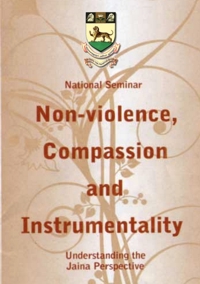Chennai 2009: Non-violence, Compassion and Instrumentality - A Jaina Perspective
 | Non-violence, Compassion and InstrumentalityA Jaina PerspectiveSeminar organized by the Department of Jainology of the University of Madras, 13 and 14 February 2009 Chennai, India |
Non-violence: Its Dimensions and Practices
13.2.2009
Introduction
“Nothing is higher than Mount Meru, and more expansive than the sky. Similarly know that no Dharma or religion is equal to Ahiṁsā or Non-Violence in this world”.
All religions and philosophies of the world have deliberately weighed non-violence, some partially and others, like Jainism, in depth. It transcends time and clime since it concerns mankind. There is no life worth the name without non-violence. Jainism regards the world as beginningless, and so is non-violence. Life and non-violence are integrally related. There is no culture in its absence.
All the religions and philosophies accept non-violence as a necessity for spiritual development. But the description of non-violence in the subtle manner as mentioned in the Jaina philosophy is not found in any other philosophy.
All beings in this world desire happiness and fear sorrow. Every being loves his life, no one wants to die. If something is done against this desire he becomes miserable. Apart from this there is another view point of sorrow. My behavior with other beings as well as my own self will be the yardstick of non- violence and violence.
Meaning
The term non-violence or ahiṁsā has various connotations. Generally it means not to kill, slay or hurt any living being. Ahiṁsā means abstention or refraining from hiṁsā.
Hiṁsā means violence, injury, harm, deprivation, mutilation, disfigurement and causing pain and suffering to others. The Jaina believes that non-violence is the supreme religion - “ahiṁsā paramo dharmaḥ”.
It postulates reverence for life and avoidance of injury. It means kindness and compassion. It means environmental protection and prevention of cruelty to animals, birds and insects.
To understand non-violence one has to understand violence. According to the Tattvārtha Sūtra; violence is explained as: “Pramattayogat pranavyaparopanam hiṁsā” which means: “Killing of any being due to negligence is violence.”
Types or forms of violence
In Jaina philosophy prāṇa (life force or vitality) is mainly of two types: (i) dravya (physical) prāṇa and (ii) bhāva (mental) prāṇa.
Dravya prāṇa refers to the five sense organs, and mind, speech, body, breathing, and lifespan. These are the ten kinds of dravya prāṇa. In the same way, bhāva prāṇa means inner peace, bliss, tranquility, knowledge and other such attributes.
Everyone is fully aware of the meaning of destruction of the dravya prāṇas in the sense of killing or getting killed. But the concept that a being has prāṇa (life force) other than visible prāṇa is unique to Jainism. These inner prāṇas are the attributes of the soul. Attachment –aversion, passions and other vices harm these attributes of the soul. When a being, driven by passions, thinks of destroying prāṇas of some other being or of oneself (suicide) he brings harm to the mental prāṇas like inner peace and tranquility. This basically is violence.
After this when he destroys the dravya or bhāva prāṇas of other beings or of himself, that too is violence. This means that in first place mental violence is committed at the very moment one has violent thoughts like attachment and aversion. The destruction of the physical prāṇas of another beings or the self may and may not follow.
Thus, “not to indulge in harming the mental and physical prāṇas of another beings or the self under the influence of stupor is called non-violence.”
From aforesaid details we arrive at the conclusion that destruction of physical or mental prāṇas of the self or the other gives us four alternative forms of violence, according to one point of view:
Mental harm to oneself (sva bhāva hiṁsā):
Under the force of circumstances or in an agitated state of mind, when a person is on the verge of committing suicide he experiences extreme stress and mental turmoil and this destroys his inner peace contentment as well as the joy and purity of his soul. This is mental harm to the self.
Physical harm to the oneself (sva dravya hiṁsā):
If a person commits suicide using some weapon, ingesting poison, jumping down from a high place, jumping before an oncoming train, hanging himself, sprinkling petrol over himself and igniting it, or by any other means this is called physical harm to oneself. It is possible that he may fail in his attempt, but in spite of not dying he has committed suicide because his bhāva prāṇa in the form of happiness and peace have certainly been destroyed for that period due to passions.
Mental harm to the other (para bhāva hiṁsā):
When a person, through his attitude or action, evokes feelings of anger, fondness, greed, etc., he intentionally disturbs the mental peace of the other person. He harms the bhāva prāṇa of the other person. He harms the bhāva prāṇa of that being. This is mental harm to the other.
Physical harm to the other (para dravya hiṁsā):
When under the influence of passions he destroys the apparent vitality of the other person he puts him to harm physically. This is physical harm to the other.
When a person is on the verge of killing another being, irrespective of the fact that the other gets killed or not, the killer has caused harm to himself because he has deprived himself of his virtues for that period of time.
Thus, defining violence and non-violence from this angle, Lord Mahāvīra pronounced that violence is the appearance of vices like attachment and aversion and non-violence is the non-appearance or absence of these vices. We commit violence in thought before we commit it in action. Violence in thought or psychic violence (bhāva hiṁsā) is the true violence. The Daśavaikālika Sūtra states that no sin accrues to one who walks, stands, sits, sleeps, eats and speaks with vigilance.
Gṛhārmbhī hiṁsā or accidental violence is that which is unavoidably committed in the performance of necessary domestic duties, such as preparation of food, keeping the things clean, construction of buildings, wells, etc.
Udyamī hiṁsā or occupational violence is performed in the exercise of one’s profession whether of a soldier, an agriculturist, a trader, or an industrialist is udyamī violence.
Virodhī hiṁsā or protective violence is that which is unavoidably committed in the defense of a person or property against assailants and enemies.
Saṁkalpī hiṁsā or intentional violence is that which is committed intentionally or knowingly, for example, hunting, offering sacrifices, killing for food, amusement or decoration, etc.
Intentional violence can be committed in thought, speech or action. Passions are the root cause for violence. The violence activities arise due to passions and as it is said earlier that it is manifested through speech and body. Anger, pride, conceit and greed are the four types of passions.
Through this only saṁrambha, samārambha, and ārambha violence occurs. The brief essence of all these is mentioned below.
Saṁrambha
The thought of violent activities to be born in this mind is saṁrambha violence.Samārambha
Making arrangement for the violent activity is called Samārambha violence.Ārambha
The activity of killing a being is called ārambha violence.Thus by multiplying the four passions into three saṁrambha, samārambha, and ārambha violence it becomes 4x3=12 types of violence. Since violence activity of mind, speech, and body by multiplying these 3 actions x l2 types = 36 types and by multiplying these 36 types into 3 kāraṇa’s [causes] i.e. to commit violence, to approve others, and to appreciate others committing violence, it becomes 108 types of violence. Hence there are 108 types of violence according to our point of view.
Ahiṁsā - A universal solution to all kinds of violence:
Most of the problems arise mainly because man fails to resolve his internal conflicts that reflect in environmental disasters. Aṇuvrata [‘atom’ vow or small vow] solves the problems by resolving the internal conflicts through rigorous training. What we interpret as do’s and don’ts of environmental management philosophy form the quintessence of Aṇuvrata.
Ahiṁsā is the prime vrata or vow to be understood and practiced by both the common man and ascetic.
The five aṇuvratas offer a solution both to the individual as also to societies and nations. Ahiṁsā is no doubt preached by all religions but Jainism has worked it out both in its negative and positive aspects in such a way that a conscientious observance of it in every thought and action is sure to safeguard both personal and social interests.
We hear incidents of religious fanatics - turned terrorists shooting down innocent people every day.
People should open their eyes and minds to samyak-jñāna, i.e. right knowledge. They should realize the universal truth that every religion in the world teaches non-violence and not violence. They may differ in other aspects, but none of them support hiṁsā. In western cultures, non-violence usually denotes passive, non-resistance, civil- disobedience; pacifism; conscientious objection to war.
Conclusion
Ācārya Bhikṣu has said that the purpose of non-violence is the purity of soul.
It is true that there is no sin greater than violence and no religion greater than non-violence in this world. Jainism has not only given importance of non-violence in terms of attitude and conduct, but has also provided profound analysis and elaboration of the concept of non-violence. Jainism has stipulated steps of conduct to progress to this level of philosophy of equality and every conduct is exclusively based on non-violence. Jainism has not confined non-violence to idealism but has given it a practical and applied form. Deprived of non-violence, Jainism would probably lose its basics of philosophy and doctrine. Hence this is the only yardstick for examining the place of non-violence in Jainism.
 G. Sunita Jain
G. Sunita Jain
